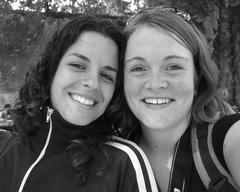Sara Navrady and Erica MooreOn the way to Sudan, they forced us to kill many people. One morning a young boy was brought to us. We were told he had tried to escape. They had killed him. His body was swollen and cut from many beatings. We were told to chop the body into smaller pieces. Boys were given the heart and liver to eat. Girls were told to cook and eat the rest of the body parts. We did as we were told. - O.R., fourteen, abducted in February 2003 (When the Sun Sets, We Start to Worry... UN OCHA, 2003) For two decades, the Lord’s Resistance Army has made this nightmare a brutal reality for thousands of children in northern Uganda. Padibe is one of numerous towns that have seen the children of its surrounding villages snatched in the middle of the night. These children are tortured, beaten, raped and drugged into submission as obedient killers or sex slaves. In the period of one night, concepts of family, home, and childhood are transformed and replaced by a brutal nomadic lifestyle, violating their bodies, their emotional sensitivity and impressionability. Recent peace talks between the LRA and the Ugandan government give hope for the release of these young soldiers. However there is little for them to return to– the village that was once their home lies in ruins, with its remaining villagers evacuated to IDP camps in the wake of destruction by the LRA. Farmland has overgrown, camouflaging the charred remains of torched schools and homes. Many of Padibe’s child soldiers were forced to participate in the destruction of their own community, and the murder of family members. Upon release, they will return with the fear of being outcasts, harbouring shame and anger towards a community that was unable to protect them. We propose to build a vessel to reunify this shattered community. Using architecture to introduce a sense of permanence, security, and reconciliation, the Afot Centre will provide the comfort of a bed, the protection of thatched rooftops and mud bricks. There are walls for drawing, football fields for playing, places to confide, heal, resolve. Overall, a sense of place reminds them that they have a home, in their community. The Centre will provide medical and counselling services to heal the broken mind and body. Education, offering alternative skills to combat, will help regenerate a collaborative community. Vocational training in agriculture and environmental planning will reconnect them with their most valuable asset– the land, addressing environmental concerns of deforestation, soil erosion and degradation. In collaboration with Shelter For Life, we- as architecture students- will participate through development research, and design of the rehabilitation complex. We envision this intervention as a prototype to be repeated with modifications across northern Uganda. People directly affected in the area would be involved from start to completion, an essential factor in establishing the project as the heart of the rebuilt community; an active means of reconnecting the children to their community and the people to the land. Additional Help and InformationAre you in need of assistance? Please email info@berkeleyprize.org. |
|

